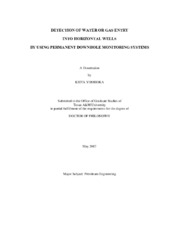| dc.description.abstract | With the recent development of temperature measurement systems, continuous wellbore
temperature profiles can be obtained with high precision. Small temperature changes can
be detected by modern temperature-measuring instruments, such as fiber optic distributed
temperature sensors (DTS) in intelligent completions. Analyzing such changes will
potentially aid the diagnosis of downhole flow conditions. In vertical wells, temperature
logs have been used successfully to diagnose the downhole flow conditions because
geothermal temperature differences in depth make the wellbore temperature sensitive to
the amount and the type of fluids flowing in the wellbore. Geothermal temperature does
not change, however, along a horizontal wellbore, which leads to small temperature
variations in horizontal wells, and interpretations of temperature profiles become harder
to make than those for vertical wells. For horizontal wells, the primary temperature
differences are caused by frictional effects. Therefore, in developing a thermal model for
producing horizontal wellbore, subtle temperature changes should be accounted for.
This study rigorously derives governing equations for thermal reservoir and
wellbore flow and develops a prediction model of temperature and pressure. With the
prediction model developed, inversion studies of synthetic and field examples are
presented. These results are essential to identify water or gas entry, to guide the flow
control devices in intelligent completions, and to decide if reservoir stimulation is needed in particular horizontal sections. This study will complete and validate these inversion
studies. The utility and effect of temperature and pressure measurement in horizontal
wells for flow condition interpretation have been demonstrated through synthetic and
field examples. | en |


